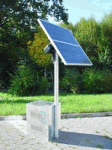 |
The obvious competitor for solar electricity
|
Rather than just coming out and saying it isn't... we'll let you draw your own
conclusion.
|
Photovoltaic or PV is the technology based on the theories of Albert
Einstein, in one of his more famous papers, he theorized that light can behave as a particle.
PV has captured the interest and ambition of a generation of researchers, and has some spectacular successes
to its credentials.
Overview:
- The common solar cell is made of silicon.
- Many cells are combined into standard panels.
- Arrays of panels are used to cover an area which becomes the solar field.
- The fielded panels are interconnected in a proscribed manner.
- The DC power form the field is sent to auxiliary equipment
- Field power can be sent to an inverter or charge controller.
- Inverted power is used promptly or sold to the utility.
- Charge controlled energy can be stored in batteries.
Practical Benefits:
- Silicon is the second most abundant element in Earth's crust.
- Panels are thin less than 2 inches, and can be fixed.
- Panels are sealed and hookup with only 2 wires.
- Inverters and controllers have no moving parts.
- All solid state, and easy to interface to computer equipment.
Technical shortcomings:
- Semiconductor grade silicon is required and expensive.
- Panels exhibit a noticeable deterioration in performance over time.
- Conversion efficiency varies from 8% to 17%.
- Inverters only offer 105% to 110% overload capacity before shutdown.
- Battery efficiency wastes energy twice; 1)charge 2)discharge.
- Batteries have a short lifetime, less than 7 years.
OK, so there is some bias here, sorry. Please don't misunderstand, PV has many applications. The
last thing we want to see is the destruction of the PV manufacturing infrastructure. Solar & Thermal
Systems will probably never make a system smaller than 1kW. In fact, some of the more interesting
system plans we have call for small bootstrap PV systems so we can concentrate on being grid isolated.
The strengths of PV are centered around the ability to generate small amounts of power for a relatively small
total cost.
The weakness of PV is centered around the enormous cost of generating large amounts of power. It's a
straight line.
Despite decades of research, the true costs have only dropped slightly. Sure, there is a million times
more capacity than there was in 1960. And the technology has passed the point where it now takes less
energy to make a solar cell than it will produce in a 20 year lifetime. But the unsubsidized cost of PV is
true reason we don't see any power-farms being built.
Go to the links page to get more information, or go straight to SolarBuzz
for a strong pro PV bias.
Interesting system:
Imagine a fleet of floating platforms the size of an ocean-going barge generating and using a few tens
of kilowatts of electricity for months or years at a time...
back
|